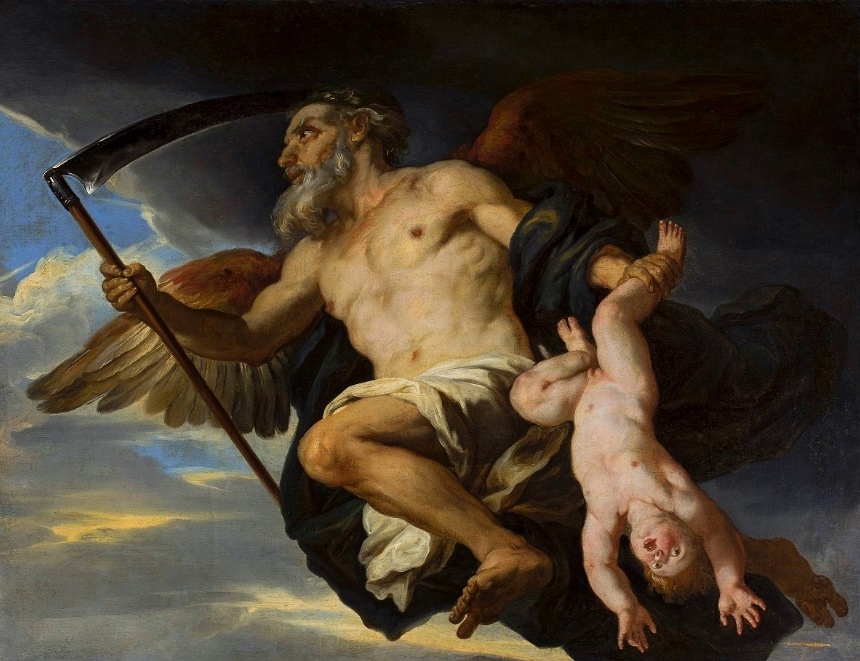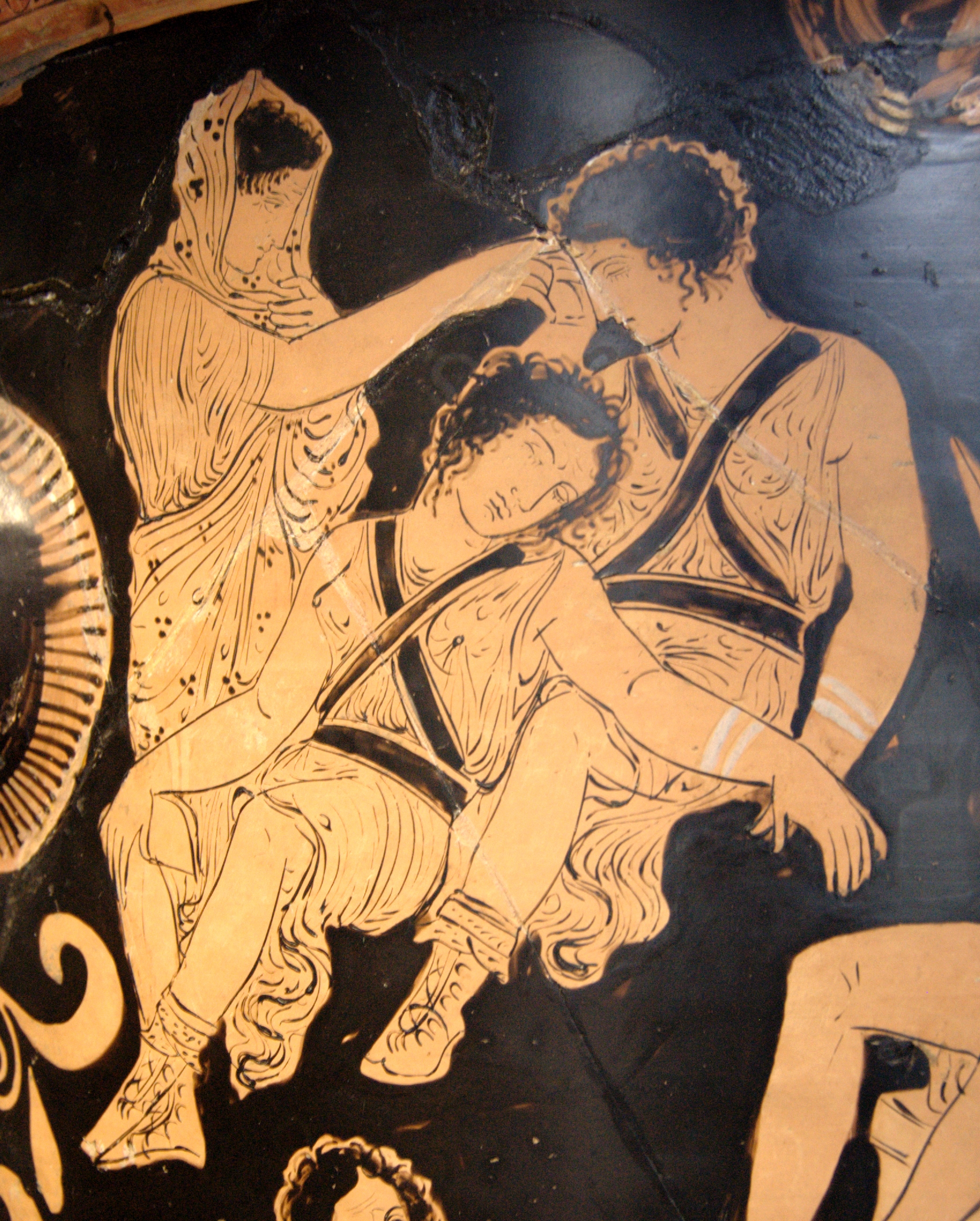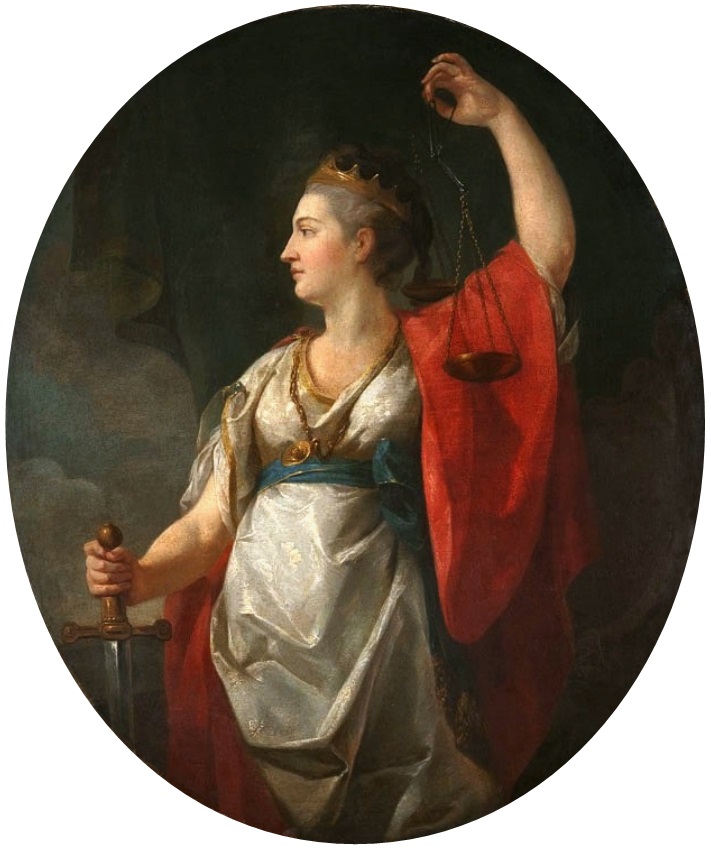|
Cronos (mythology)
In Ancient Greek religion and mythology, Cronus, Cronos, or Kronos ( or , from el, Κρόνος, ''Krónos'') was the leader and youngest of the first generation of Titans, the divine descendants of the primordial Gaia (Mother Earth) and Uranus (Father Sky). He overthrew his father and ruled during the mythological Golden Age, until he was overthrown by his own son Zeus and imprisoned in Tartarus. According to Plato, however, the deities Phorcys, Cronus, and Rhea were the eldest children of Oceanus and Tethys. Cronus was usually depicted with a harpe, scythe or a sickle, which was the instrument he used to castrate and depose Uranus, his father. In Athens, on the twelfth day of the Attic month of Hekatombaion, a festival called Kronia was held in honour of Cronus to celebrate the harvest, suggesting that, as a result of his association with the virtuous Golden Age, Cronus continued to preside as a patron of the harvest. Cronus was also identified in classical antiq ... [...More Info...] [...Related Items...] OR: [Wikipedia] [Google] [Baidu] |
Chronos
Chronos (; grc-gre, Χρόνος, , "time"), also spelled Khronos or Chronus, is a personification of time in pre-Socratic philosophy and later literature. Chronos is frequently confused with, or perhaps consciously identified with, the Titan Cronus in antiquity due to the similarity in names. The identification became more widespread during the Renaissance, giving rise to the iconography of Father Time wielding the harvesting scythe. Greco-Roman mosaics depicted Chronos as a man turning the zodiac wheel. He is comparable to the deity Aion as a symbol of cyclical time. He is usually portrayed as an old callous man with a thick grey beard, personifying the destructive and stifling aspects of time. Name During antiquity, Chronos was occasionally interpreted as Cronus. According to Plutarch, the Greeks believed that Cronus was an allegorical name for Chronos. Mythology In the Orphic tradition, the unaging Chronos was "engendered" by "earth and water", and produced Aether, ... [...More Info...] [...Related Items...] OR: [Wikipedia] [Google] [Baidu] |
Iapetus (mythology)
In Greek mythology, Iapetus (; ; grc, Ἰαπετός, Iapetós), also Japetus, is a Titan, the son of Uranus and Gaia and father of Atlas, Prometheus, Epimetheus, and Menoetius. He was also called the father of Buphagus and Anchiale in other sources. Iapetus was linked to Japheth (יֶפֶת) one of the sons of Noah and a progenitor of mankind in biblical accounts. The practice by early historians and biblical scholars of identifying various historical nations and ethnic groups as descendants of Japheth, together with the similarity of their names, led to a fusion of their identities, from the early modern period to the present. Mythology Iapetus ("the Piercer") is the one Titan mentioned by Homer in the ''Iliad'' as being in Tartarus with Cronus. He is a brother of Cronus, who ruled the world during the Golden Age but is now locked up in Tartarus along with Iapetus, where neither breeze nor light of the sun reaches them. Iapetus' wife is usually described as a daught ... [...More Info...] [...Related Items...] OR: [Wikipedia] [Google] [Baidu] |
Aphrodite
Aphrodite ( ; grc-gre, Ἀφροδίτη, Aphrodítē; , , ) is an ancient Greek goddess associated with love, lust, beauty, pleasure, passion, and procreation. She was syncretized with the Roman goddess . Aphrodite's major symbols include myrtles, roses, doves, sparrows, and swans. The cult of Aphrodite was largely derived from that of the Phoenician goddess Astarte, a cognate of the East Semitic goddess Ishtar, whose cult was based on the Sumerian cult of Inanna. Aphrodite's main cult centers were Cythera, Cyprus, Corinth, and Athens. Her main festival was the Aphrodisia, which was celebrated annually in midsummer. In Laconia, Aphrodite was worshipped as a warrior goddess. She was also the patron goddess of prostitutes, an association which led early scholars to propose the concept of "sacred prostitution" in Greco-Roman culture, an idea which is now generally seen as erroneous. In Hesiod's ''Theogony'', Aphrodite is born off the coast of Cythera from the foam (, ) ... [...More Info...] [...Related Items...] OR: [Wikipedia] [Google] [Baidu] |
Meliae
In Greek mythology, the Meliae (also called Meliads) (; grc, Μελίαι, or , ) were usually considered to be the nymphs of the ash tree, whose name they shared. Mythology According to Hesiod, the Meliae (probably meaning all tree-nymphs) were born from the drops of blood that fell on Gaia arthwhen Cronus castrated Uranus. In Hesiod's ''Works and Days'', the ash trees, perhaps meaning the Melian nymphs, are said to have been the progenitors of the generation of men belonging to Hesiod's Bronze Age. The Meliae were nurses of the infant Zeus in the Cretan Dikti mountains, according to the 3rd century BC poet Callimachus, ''Hymn to Zeus'', where they fed him on the milk of the goat Amalthea and honey. Callimachus appears to make the Theban nymph Melia, who was, by Apollo, the mother of Tenerus and Ismenus, one of the "earth-born" Meliae. Elsewhere, however, this Melia is an Oceanid, one of the many daughters of Oceanus and Tethys.Pindar, ''Paean 9'' fr. 52k 38–46; Paus ... [...More Info...] [...Related Items...] OR: [Wikipedia] [Google] [Baidu] |
Erinyes
The Erinyes ( ; sing. Erinys ; grc, Ἐρινύες, pl. of ), also known as the Furies, and the Eumenides, were female chthonic deities of vengeance in ancient Greek religion and mythology. A formulaic oath in the ''Iliad'' invokes them as "the Erinyes, that under earth take vengeance on men, whosoever hath sworn a false oath". Walter Burkert suggests that they are "an embodiment of the act of self-cursing contained in the oath". They correspond to the Dirae in Roman mythology. The Roman writer Maurus Servius Honoratus wrote (ca. 400 AD) that they are called "Eumenides" in hell, "Furiae" on Earth, and "Dirae" in heaven. Erinyes are akin to some other Greek deities, called Poenai. According to Hesiod's ''Theogony'', when the Titan Cronus castrated his father, Uranus, and threw his genitalia into the sea, the Erinyes (along with the Giants and the Meliae) emerged from the drops of blood which fell on the Earth ( Gaia), while Aphrodite was born from the crests of sea ... [...More Info...] [...Related Items...] OR: [Wikipedia] [Google] [Baidu] |
Giants (Greek Mythology)
In Greek and Roman mythology, the Giants, also called Gigantes (Greek: Γίγαντες, ''Gígantes'', Γίγας, ''Gígas''), were a race of great strength and aggression, though not necessarily of great size. They were known for the Gigantomachy (or Gigantomachia), their battle with the Olympian gods. According to Hesiod, the Giants were the offspring of Gaia (Earth), born from the blood that fell when Uranus (Sky) was castrated by his Titan son Cronus. Archaic and Classical representations show Gigantes as man-sized hoplites (heavily armed ancient Greek foot soldiers) fully human in form. Later representations (after c. 380 BC) show Gigantes with snakes for legs. In later traditions, the Giants were often confused with other opponents of the Olympians, particularly the Titans, an earlier generation of large and powerful children of Gaia and Uranus. The vanquished Giants were said to be buried under volcanoes and to be the cause of volcanic eruptions and earthquakes. O ... [...More Info...] [...Related Items...] OR: [Wikipedia] [Google] [Baidu] |
Arges (Cyclops)
Arges ( gr, Ἄργης) was one of the three Hesiodic Cyclopes in Greek mythology. He was elsewhere called Acmonides or Pyracmon. His name means "bright" and represents the brightness from lightning. Birth and forging of the lightning bolt Arges is a child of Gaia and Uranus, and his siblings include his fellow cyclopes, Brontes and Steropes, along with the Titans and the Hundred Handed Ones. After his birth, Uranus is said to have locked Arges and his cyclopes brothers in Tartarus out of fear, along with the Hundred Handed Ones. During the war between the Titans and the Gods, Arges, Brontes, and Steropes were freed to fashion lightning bolts for Zeus during his attempt to overthrow the gods. According to Apollodorus, Arges and his fellow cyclopes also fashioned the Helmet of Invisibility for Hades, and the trident for Poseidon. These weapons played a key role in the downfall of the Titans. Possible death In Hesiod's Catalogue of Women, the three Cyclopes, including Arges ... [...More Info...] [...Related Items...] OR: [Wikipedia] [Google] [Baidu] |
Cyclopes
In Greek mythology and later Roman mythology, the Cyclopes ( ; el, Κύκλωπες, ''Kýklōpes'', "Circle-eyes" or "Round-eyes"; singular Cyclops ; , ''Kýklōps'') are giant one-eyed creatures. Three groups of Cyclopes can be distinguished. In Hesiod's ''Theogony'', the Cyclopes are the three brothers Brontes, Steropes, and Arges, who made for Zeus his weapon the thunderbolt. In Homer's ''Odyssey'', they are an uncivilized group of shepherds, the brethren of Polyphemus encountered by Odysseus. Cyclopes were also famous as the builders of the Cyclopean walls of Mycenae and Tiryns. In ''Cyclops'', the fifth-century BC play by Euripides, a chorus of satyrs offers comic relief based on the encounter of Odysseus and Polyphemus. The third-century BC poet Callimachus makes the Hesiodic Cyclopes the assistants of smith-god Hephaestus; as does Virgil in the Latin epic ''Aeneid'', where he seems to equate the Hesiodic and Homeric Cyclopes. From at least the fifth century BC, Cyc ... [...More Info...] [...Related Items...] OR: [Wikipedia] [Google] [Baidu] |
Hecatoncheires
In Greek mythology, the Hecatoncheires ( grc-gre, Ἑκατόγχειρες, , Hundred-Handed Ones), or Hundred-Handers, also called the Centimanes, (; la, Centimani), named Cottus, Briareus (or Aegaeon) and Gyges (or Gyes), were three monstrous giants, of enormous size and strength, each with fifty heads and one hundred arms. In the standard tradition they were the offspring of Uranus (Sky) and of Gaia (Earth), and helped Zeus and the Olympians to overthrow the Titans in the Titanomachy. Names The three Hundred-Handers were named Cottus, Briareus and Gyges. Cottus (''Κόττος'') is a common Thracian name, and is perhaps related to the name of the Thracian goddess Kotys. The name Briareus (''Βριάρεως'') was probably formed from the Greek ''βριαρός'' meaning "strong". Hesiod's ''Theogony'' also calls him "Obriareus". The name Gyges is possibly related to the mythical Attic king Ogyges (''Ὠγύγης''). "Gyes", rather than Gyges, is found in some texts. H ... [...More Info...] [...Related Items...] OR: [Wikipedia] [Google] [Baidu] |
Themis
In Greek mythology and Ancient Greek religion, religion, Themis (; grc, Θέμις, Themis, justice, law, custom) is one of the twelve Titans, Titan children of Gaia and Uranus (mythology), Uranus, and the second wife of Zeus. She is the goddess and personification of justice, divine order, fairness, law, and custom, and her symbols include the Scales of Justice (symbol), Scales of Justice. She is also associated with oracles and prophecies, including the Pythia, Oracle of Delphi. Name ''Themis'' means "divine law" rather than human ordinance, literally "that which is put in place", from the Greek verb ''títhēmi'' (wikt:τίθημι, τίθημι), meaning "to put." To the ancient Greeks she was originally the organizer of the "communal affairs of humans, particularly assemblies." Moses Finley remarked of ''themis'', as the word was used by Homer in the 8th century BCE, to evoke the social order of the 10th- and 9th-century Greek Dark Ages: Finley adds, "There was ''them ... [...More Info...] [...Related Items...] OR: [Wikipedia] [Google] [Baidu] |
Theia
In Greek mythology, Theia (; grc, Θεία, Theía, divine, also rendered Thea or Thia), also called Euryphaessa ( grc, Εὐρυφάεσσα) "wide-shining", is one of the twelve Titans, the children of the earth goddess Gaia and the sky god Uranus. She is the Greek goddess of sight and vision, and by extension the goddess who endowed gold, silver and gems with their brilliance and intrinsic value. Her brother-consort is Hyperion, a Titan and god of the sun, and together they are the parents of Helios (the Sun), Selene (the Moon), and Eos (the Dawn). She seems to be the same with Aethra, the consort of Hyperion and mother of his children in some accounts. Like her husband, Theia features scarcely in myth, being mostly important for the children she bore, though she appears in some texts and rare traditions. Etymology The name ''Theia'' alone means simply "goddess" or "divine"; ''Theia Euryphaessa'' () brings overtones of extent (, ''eurys'', "wide", root: ) and brightness ... [...More Info...] [...Related Items...] OR: [Wikipedia] [Google] [Baidu] |
Tethys (mythology)
In Greek mythology, Tethys (; grc, Τηθύς, Tēthýs) was a Titans, Titan daughter of Uranus (mythology), Uranus and Gaia (mythology), Gaia, a sister and wife of the Titan Oceanus, and the mother of the Potamoi, river gods and the Oceanids. Although Tethys had no active role in Greek mythology and no established cults, she was depicted in mosaics decorating baths, pools, and triclinium, triclinia in the Greek East, particularly in Antioch and its suburbs, either alone or with Oceanus. Genealogy Tethys was one of the Titan offspring of Uranus (Sky) and Gaia (Earth). Hesiod lists her Titan siblings as Oceanus, Coeus, Crius, Hyperion (mythology), Hyperion, Iapetus (mythology), Iapetus, Theia, Rhea (mythology), Rhea, Themis, Mnemosyne, Phoebe (mythology), Phoebe, and Cronus. Tethys married her brother Oceanus, an enormous river encircling the world, and was by him the mother of numerous sons (the Potamoi, river gods) and numerous daughters (the Oceanids). According to Hesiod, th ... [...More Info...] [...Related Items...] OR: [Wikipedia] [Google] [Baidu] |







